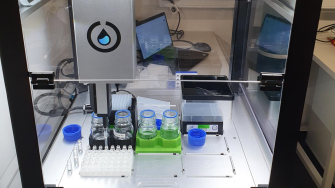The Chemistry AI Revolution: developing a high throughput technique to analyse complex chemical structures
Researchers from UNSW Sydney have developed a machine learning algorithm trained to identify and group supramolecules.
Researchers from UNSW Sydney have developed a machine learning algorithm trained to identify and group supramolecules.

A new method for analysing the complexity of chemical reactions, using a technique known as ion mobility mass spectrometry, coupled with simple machine learning, has been developed by scientists from the UNSW School of Chemistry.
The new method, recently outlined in the journal Angewandte Chemie, could be used by scientists who study supramolecules in a range of research fields – from drug discovery to material design.
Supramolecules rely on noncovalent interactions between small molecules to self-assemble into larger, more complex entities.
“In our case, we’re building supramolecules using molecular subunits,” says Dr Nicole Rijs, a lead author on the study. “These subunits are joined together using non-covalent bonding, so instead of being welded together by strong bonds – known as covalent bonds – they can loosely join together in random shapes. And a supramolecule is a molecule built up of those subunits.”
Because of their loose chemical architecture, supramolecules are often formed in a specific way. “Creating supramolecules doesn’t require much energy,” says Dr Rijs. “In fact, there is a really low energy threshold to get them to form those interesting, bigger subunits.”
This means that if you are creating supramolecules in the lab, then the process is very simple. You can simply mix the subunits together, and they will naturally find each other and self-assemble to form those more complex structures. The difficulty with this kind of chemistry is that it can be challenging to identify exactly what you are building along the way.
“No reaction is that simple, there's never just one reactant that reacts with another, like what we learn in an organic chemistry class. Even when you're doing a reaction in a synthetic flask, tiny amounts of other things can change everything,” says Dr Rijs.
Dr Rijs and her team set out to develop a way to analyse the complexity of these self-assembling supramolecules that was efficient and high throughput. And to achieve such a feat, they turned to AI.
Many biological molecules self assemble as supramolecules. For example, proteins, which are made up of amino-acids, form and exist in this way.
“Lots of people use a lego analogy. The subunits are like individual lego pieces that can build a particular shape that has a specific function. And then you can pull that shape apart and make a different shape with the same subunits,” says Dr Rijs.
“Currently, scientists are trying to make these more complex molecules from easy, low energy mixes of building blocks,” says Dr Rijs.
The challenge here is embracing the complexity of the reaction and instead of analysing isolated molecules, being able to characterise a dynamic chemical composition, which involves an ensemble of components. Currently, there aren’t many techniques available for identifying the unique molecules that are all being created at the same time.
Dr Rijs, together with PhD candidate Oscar Williams and their team, used a liquid-handling robot to prepare over 800 reactions between different metals and other reactants, which spontaneously produced more supramolecular assemblies.
The product of the self-assembling reactions were analysed at various time points using Ion Mobility – Mass Spectrometry. Ion Mobility – Mass Spectrometry measures how heavy something is (mass) but also how big something is (shape), to identify what the molecule is.
This data was then fed into an machine learning algorithm which determines how different the supramolecules are from each other, at each stage of the reaction, without the need for ‘structural assignment’ – a time-consuming method which uses Nuclear Magnetic Resonance (NMR) to identify molecular structure.
“In this paper, we analysed over 800 reactions, and measured how much of each supramolecule was produced by each reaction, and monitored how quickly things form. But we did this in a high throughput way, allowing for AI and machine learning by taking some important chemical data and making it digital, in a fully scalable way,” says Dr Rijs.
Dr Rijs and her team have developed a technique which identifies parts of complex chemical mixtures that are often invisible to other techniques.
“We also can get that chemical information out and digitise it, and we made an efficient way that lets the information be fed in to machine learning.
“The complex behaviour of the self-assembling systems was reduced to simpler qualities, which could be automatically processed,” says Dr Rijs. “Now the door is open to input a vast variety of other complex systems.”
“A really big question in a lot of fields at the moment is how to grapple with complexity, because we're moving away from a regime where we're just looking at single molecule entities and we want to know how an ensemble of things is behaving at once,” says Dr Rijs.
So importantly, this method is scalable, which means that other researchers will be able to use the algorithms developed to screen a wide range of chemical structures and observe other self-assembled products.
“For example, this process is important for researchers who study the origins of life – how we get from a chemical soup to something that looks more like biomolecules. It’s also essential in drug discovery, to see how things might behave in the body, when there are lots of possible off-target reactions that could occur.
“Such data can now be generated at scale and used as a training set for AI, which is important because these systems currently lack good chemical training sets. Our method is new and straightforward enough that I expect others are in the field are likely to use it. Ion mobility is a cutting edge technology, so whatever new things it is applied to can be ground breaking. The structural information from Ion Mobility – Mass Spectrometry is currently underutilised, but I foresee it being an important part of future chemical discoveries.”